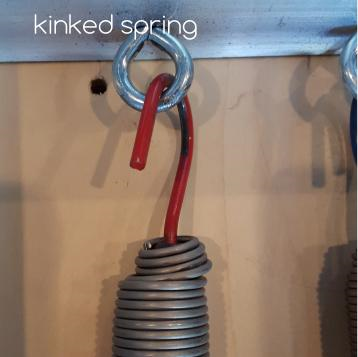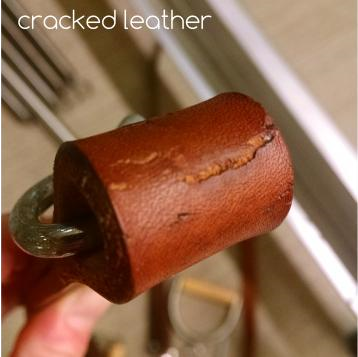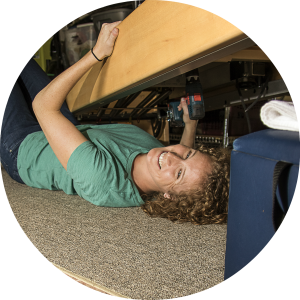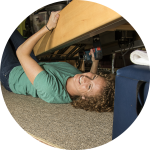Don’t Be Afraid of the Nuts and Bolts: Easy equipment maintenance for Pilates Instructors – by Kaleen Canevari
One of the first things the professor in my college Introduction to Engineering course told the class was that that no mechanical invention is truly unique. Everything we make or work on as engineers already exists somewhere in nature. Most notably, the human body.
My education as a maker and an engineer has been a long and incredibly fun one. I love figuring things out. The challenge of understanding all the parts to make the contraption smoother, faster, stronger, quieter, or better drives me. The use of my body and brain to create is addicting. It’s where I find my “flow.”
I imagine you feel similarly as a Pilates instructor, analyzing body movement and reworking components to make it function properly. Just like a mechanical engineer might work on a car engine, a Pilates instructor works on the human body.
Last year, as I transitioned from being a design engineer for Balanced Body to running my own Pilates equipment maintenance and repair company, I visited studios using all types and brands of equipment. Stott, Gratz, Peak and Balanced Body, to name the big players. I’ve been surprised how many of my clients don’t realize until our visit is over that so much is required to take care of their valuable healing tools. Even more surprising is how intimidated many of them are to even get their hands dirty!
Now, I’m not saying that everyone can and should get their own set of tools and immediately start adjusting and tuning the machines. But I am advocating that you, as a Pilates instructor, are an already an accomplished engineer of the body and can most certainly learn the basics of taking care of your own equipment. After all, the Reformer, Cadillac and Chair are way less complicated than the human body!
The problem you’ve probably faced, though, has been that there really is no good way of learning how to do it. The manufacturers put out a few videos and they may even have a wonderful tech support guy to walk you through glaring issues. There are even a few Professional Pilates Equipment Specialists scattered around the US, but unless your studio is close to one of them, travel costs add up quickly. It is far too easy to fall prey to the “out of sight, out of mind,” attitude when it comes to equipment maintenance.
Instead, I encourage you to start thinking about your Pilates equipment like any other big investment you make, such as your car or your house. Both require regular maintenance and occasional repairs, just like your Pilates equipment. Many instructors and owners I serve have had their equipment for twenty years, and it has slowly morphed into a sticky and squeaky mess because they were unaware that the equipment needed any special care beyond disinfecting for the client. Yes, it is a wonderful testament to the craftsmanship of the equipment that these tools last so long (especially in today’s disposable world). But often these changes happen slowly over time, so they go unnoticed and the user gradually adjusts to the declining performance of the equipment.
To get started, here is a quick list of things you should be doing regularly to keep your equipment healthy:
 • Springs- The most common question my clients ask is whether they really have to replace their springs every two years. Quick answer: Yes! Check every quarter for S-waves in the coils, and severe coil displacement. I often find Reformer springs look fine near the footbar, but under the carriage there can be some crazy looking anomalies. Replace anything right away that looks abnormal, and be sure to stick to your manufacturer’s recommended replacement schedule. Springs break more often than you might think!
• Springs- The most common question my clients ask is whether they really have to replace their springs every two years. Quick answer: Yes! Check every quarter for S-waves in the coils, and severe coil displacement. I often find Reformer springs look fine near the footbar, but under the carriage there can be some crazy looking anomalies. Replace anything right away that looks abnormal, and be sure to stick to your manufacturer’s recommended replacement schedule. Springs break more often than you might think!
• Ropes, loops and handles- Check quarterly for frayed stitching and fuzzy ropes. This can quickly become a safety hazard.
 • Wheels and Rails- These are by far the most important key to longevity and preservation of the “feel” of the Reformer. Clean your rails weekly, and be sure to wipe the wheels when you do. A little elbow grease goes a long way, here! Keeping dust, debris and hair out of the wheel bearings and off the surface will keep your carriage rolling smoothly for a long time. No special cleaner is needed, just water and a rag. Avoid silicone spray!
• Wheels and Rails- These are by far the most important key to longevity and preservation of the “feel” of the Reformer. Clean your rails weekly, and be sure to wipe the wheels when you do. A little elbow grease goes a long way, here! Keeping dust, debris and hair out of the wheel bearings and off the surface will keep your carriage rolling smoothly for a long time. No special cleaner is needed, just water and a rag. Avoid silicone spray!
• Upholstery- The second most common question I get is about vinyl cleaner. Most manufacturers recommend avoiding essential oils. Not only does Naugahyde, the manufacturer of most of the industry’s vinyl, say that it will break down the component in the vinyl that keeps it soft (causing it to crack), but it may void your warranty through one of the equipment manufacturers. That being said, many of my clients have used a very diluted solution for years with no problems. Some alternatives include Method Lavender, Balanced Body Clean, or mild dish soap diluted in water.
• Nuts and bolts- As the weather changes, your wooden equipment may expand and contract causing some nuts and bolts to loosen. With any equipment, use and vibration can cause things to come loose over time, too. Be sure to check that everything is secure on a monthly basis, especially your risers. If you have a chronically loose bolt, usually you can add some blue Loctite to correct this problem. Check with me or your manufacturer to make sure it isn’t a safety issue.

• Leather Straps- Spend some time every quarter to clean your leather straps with saddle soap. As anyone in the ranching industry can attest, soft, supple leather is not only more comfortable but lasts longer and won’t crack or break during use.
Keep in mind that if you plan to keep your equipment longer than 4 or 5 years, you’ll probably need to replace worn down parts. Just like a car needs periodic oil changes and new tires, your equipment will need new springs, upholstery, wheels, ropes and loops, and sometimes even small hardware throughout its life. This is just part of owning and using a complex machine.
As you get used to crawling around your equipment, you’ll become more comfortable diagnosing and fixing things yourself, and budgeting for replacement parts to keep your equipment running like new. This equipment can last a lifetime if you want it to.
If you ever have any questions no matter how simple or complicated, don’t hesitate to contact me or call your manufacturer’s tech support line. Just as you invest time in keeping your body healthy, spend some time keeping your equipment healthy, too.

Kaleen is a mechanical engineer, Pilates instructor, and owner of The Fit Reformer, a Pilates equipment maintenance and repair company. Her love for Pilates blossomed while working for Balanced Body as an engineer, designing and testing studio equipment. She currently splits her time teaching Pilates at home in Georgia and traveling the country to make old Pilates equipment feel like new again.
Not only does Kaleen love to get her hands dirty working on Pilates equipment, she loves teaching other studio owners and instructors how to do it, too. On FitReformer.com you can check out her DIY video series, browse the latest #studiotips, purchase replacement parts for your equipment, and schedule a personal consultation.

